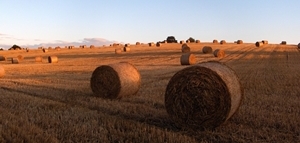|
|

 |
Vitamin C Natural Food Sources for Optimum Health
by Ralph Teller |

|
Vitamin C Facts and Health Benefits
Vitamin C, also called ascorbic acid, is naturally present in some foods. As humans are unable to internally synthesize Vitamin C, it is an essential vitamin that we obtain only from our diet. High levels of Vitamin C concentration in our cells and tissues are found in white blood cells, eyes, adrenal glands, pituitary gland, and our brain.
Vitamin C plays several key functions necessary to our optimum health, including:
- - Collagen. Vitamin C is required for the biosythesis of Collagen. Collagen is a group of naturally occurring proteins which make up about 25% to 35% of our whole-body protein content. Collagen is a key ingredient of our tendons, ligaments and skin, and is also abundant in our cornea, cartilage, bone, and blood vessels.
- - Wound Healing. Collagen also is an essential component of connective tissue, which plays a vital role in wound healing.
- - Iron Absorption. Vitamin C improves the absorption of nonheme iron, the form of iron present in plant-based foods. See Natural Sources of Iron
- - Immune System. Vitamin C is important to maintain a strong immune system, reflected in part by the high concentration of Vitamin C in white blood cells. White blood cells help build a strong immune by defending the body against both infectious disease and foreign materials. See How to Prevent and Treat Colds Naturally
- - Teeth, Gums and Eyes.Vitamin C promote strong teeth, gums and eyes.
- - Antioxidant. Research is examining whether Vitamin C, by limiting the damaging effects of free radicals through its antioxidant activity, might help prevent or delay the development of certain cancers, cardiovascular disease, and other diseases in which oxidative stress plays a role.
Athletes need higher amounts of Vitamin C to help keep their tendons and ligaments strong to prevent injury and to help to absorp iron to make red blood cells. Women of child bearing age also have increased needs for Vitamin C for red blood cell production. Natural Food Sources of Vitamin C
Fruits and vegetables are the best sources of Vitamin C.
Natural Food Sources of Vitamin C | Food | Milligrams (mg) per serving | Percent (%) DV* |
|---|
| Red pepper, raw, ½ cup | 95 | 158 |
| Guava, ¼ cup |
94 |
157 | | Orange juice, ¾ cup | 93 | 155 | | Orange, 1 medium | 70 | 117 | | Grapefruit juice, ¾ cup | 70 | 117 | | Kiwifruit, 1 medium | 64 | 107 | | Green pepper, raw, ½ cup | 60 | 100 | | Broccoli, cooked, ½ cup | 51 | 85 | | Strawberries, fresh, ½ cup | 49 | 82 | | Brussels sprouts, cooked, ½ cup | 48 | 80 | | Lemons, 1 lemon |
44 |
73 | >
| Papaya, ½ cup |
43 |
72 | >| Grapefruit, ½ medium | 39 | 65 | | Broccoli, raw, ½ cup | 39 | 65 | | Tomato juice, ¾ cup | 33 | 55 | | Cantaloupe, ½ cup | 29 | 48 | | Cabbage, cooked, ½ cup | 28 | 47 | | Cauliflower, raw, ½ cup | 26 | 43 | | Potato, baked, 1 medium | 20 | 33 | | Tomato, raw, 1 medium | 17 | 28 | | Spinach, cooked, ½ cup | 9 | 15 | | Green peas, cooked, ½ cup | 8 | 13 |
*DV = Daily Value. DVs were developed by the U.S. Food and Drug Administration (FDA) to help consumers compare the nutrient contents of products within the context of a total diet
Vitamin C Recommended Daily Intake
Intake recommendations for vitamin C and other nutrients are provided in the Dietary Reference Intakes (DRIs) developed by the Food and Nutrition Board at the Institute of Medicine. The RDAs for Vitamin C are based on its known physiological and antioxidant functions in white blood cells and are much higher than the amount required for protection from deficiency.
Recommended Dietary Allowances (RDAs) for Vitamin C
| Age | Male | Female | Pregnancy | Lactation |
|---|
| 0–6 months | 40 mg* | 40 mg* | | | | 7–12 months | 50 mg* | 50 mg* | | | | 1–3 years | 15 mg | 15 mg | | | | 4–8 years | 25 mg | 25 mg | | | | 9–13 years | 45 mg | 45 mg | | | | 14–18 years | 75 mg | 65 mg | 80 mg | 115 mg | | 19+ years | 90 mg | 75 mg | 85 mg | 120 mg | | Smokers | Individuals who smoke require 35 mg/day more vitamin C than nonsmokers. |
* Adequate Intake (AI)
Vitamin C Deficiency
If you do not get enough vitamin C you can develop Scurvy. Symptoms of scurvy include general weakness, anemia, gum disease and bruising.
More about Ralph Teller. See Ralph's 1Vigor Log Calendar.
<-- back to top |
1Vigor Log Contest
 Win Prizes! Prizes to the Male and Female who logs the most distance running, hiking, swimming, cycling, pushups on the 1Vigor Log . . . Read more
Win Prizes! Prizes to the Male and Female who logs the most distance running, hiking, swimming, cycling, pushups on the 1Vigor Log . . . Read more |
Books on 1Vigor Recommended reading on swimming, running, cycling, adventure, natural health, nutrition, brain power, nerve force, men's health, hiking, women's health . . . See Books!
Recommended reading on swimming, running, cycling, adventure, natural health, nutrition, brain power, nerve force, men's health, hiking, women's health . . . See Books! |
Articles on Vitamin C
 Dietary Supplement Fact Sheet:
Vitamin C, Dietary Supplement Fact Sheet, National Institute of Health Dietary Supplement Fact Sheet:
Vitamin C, Dietary Supplement Fact Sheet, National Institute of Health
 Natural Sources of Vitamin C, by Deborah Dunham, Livestrong Natural Sources of Vitamin C, by Deborah Dunham, Livestrong
|
